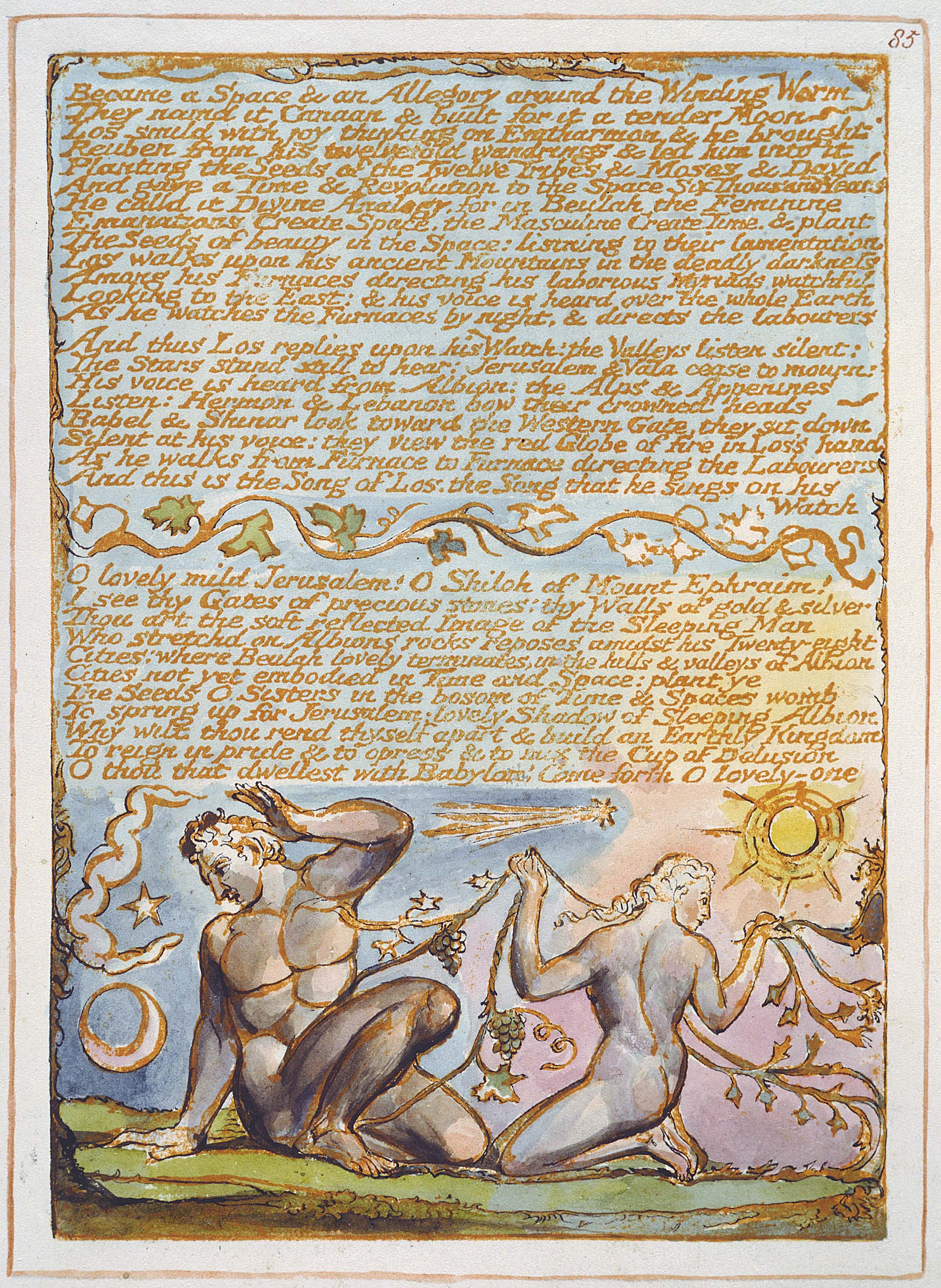DISCUSSION
with intellectual spears & long winged arrows of thought
Pudendaddendum
In “Some Sexual Connotations” (Blake 16 [Winter 1982-83], 166-71), I attempted to detail the overt sexual referents in several polysemous, or “multi-stable,” textual passages and illustrations. Such referents are significant not only in their own right, proof of Blake’s practice of “No Secrecy in Art,” but as well for the way in which they are contained in their overdetermined context, since “what is not too Explicit” is “the fittest for Instruction because it rouzes the faculties to act” (letter to Trusler, 23 August 1799). This context includes, as Blake puts it on the titlepage of The Four Zoas, “The torments of Love & Jealousy”; and it includes those torments in their most physical and emotional expression.
As for overt sexual imagery, I am happy to find Brenda Webster’s independent suggestion of the Rahabpenis figure in Jerusalem, pl. 75 (Blake’s Prophetic Psychology [Athens, Ga.: Univ. of Georgia Press, 1983], p. 286; reproduced in “Some Sexual Connotations,” p. 170). But I am ashamed (pudeo!) to have to add another instance, and one, no less, from an illustration accompanying my earlier discussion. Perhaps there is consolation in thinking that the realization of such repression of the signifier is a promise of pleasure to come as we learn to read Blake with fewer inhibitions, in greater polymorphous perversity: with the enjoyment of all his senses. Jerusalem, pl. 85, copy E (illus.), like the other designs discussed in “Some Sexual Connotations,” offers a “multistable” image as well, since the figure of Los’s doubled right leg stands out from its ground as a side-on view of a tumescent penis (foreskin not yet drawn back). The two clusters of grapes might in this case suggest (removed?)
begin page 236 | ↑ back to top testicles, or sperm “removed” by being “fibred” over to/by Enitharmon: a sort of conceptual representation of intercourse (note how one collateral fibre does branch off toward/from the area of Los’s heart). The difficulty in seeing such images—as this addendum witnesses—is that they are, at first, so unexpected. Here the viewer has to be able to enter the image and make some of the connections: to focus on the shaded body of the leg, treating it as one form, to continue the outline of the penis-form through the ankle lines, to disregard the light area of the foot, even to see the upper outline of the left leg as no outline but another fibre (not that difficult if one tries to conceive how, as an outline, it connects to the trunk of the body). The foreskin is marked by the kneecap and the orifice by the small circle, resembling an indentation, across from the top of the lower cluster of grapes. One need only trust the initial impression that there’s something oddly emphasized about this (third) leg, that it seems to possess a life and existence of its own. This erection might serve to explain why Los and Enitharmon are so emphatically looking away from each other, not wishing to acknowledge the (pictorially-speaking, anyway) most important thing between them.Which leads us to a reconsideration of the implied ascetic message of the lines quoted from “My Spectre” in “Some Sexual Connotations,” p. 171 (11. 49-52 [erroneously cited as 67-70]; see also Ostriker’s remarks in the same issue, p. 161). It now seems to me that a truly “radical” argument might be read as, in effect, “let’s forget about ‘Love’ and get physical—really ‘tear up,’ ‘root up’ the ‘infernal grove.’ Then, having disposed of the lineaments of gratified desire, may we ‘return & see / The worlds of happy Eternity.’ ” The crucial point, what allows the return and vision of the worlds, is the initial mutual agreement. This might explain why the phrase is repeated. Thus the speaker argues, at first:
Till I turn from Female LoveBut it can’t be done alone. Eternity, in fact, is nothing but this ongoing process of agreeing, rooting up, and returning. So, the speaker concludes:
And root up the Infernal Grove
I shall never worthy be
To Step into Eternity (41-44)
Let us agree to give up LoveSo should all couples consummate “the fleshly bread . . . the nervous wine” (FZ 12.44).
And root up the infernal grove
Then shall we return & see
The worlds of happy Eternity
& Throughout all Eternity
I forgive you you forgive me
As our Dear Redeemer said
This the Wine & this the Bread (49-56)

